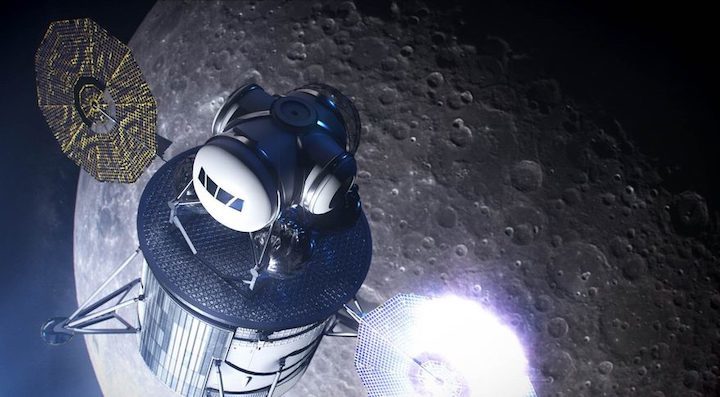4.09.2019

WASHINGTON — NASA has updated a draft solicitation for crewed lunar landers, adjusting details about how it plans to procure landers to meet the agency’s goal of landing humans on the moon by 2024.
NASA published Aug. 30 a second draft of a broad agency announcement for what the agency calls the Human Landing System, which will be used to transport astronauts from the Gateway to the lunar surface and back as part of NASA’s overall Artemis program. The announcement, like the original draft published July 19, is part of NASA’s Next Space Technologies for Exploration Partnerships (NextSTEP) program.
The revised draft maintains the basic outlines of the program, including NASA’s plans to acquire lunar lander services from companies, rather than the landers themselves. Selected companies would develop an initial version of the lander to support missions in 2024 and 2025, followed by a more advanced “sustainable” lander in 2026.
The revised version instead incorporates smaller changes based on industry feedback to the initial draft. “We read and adjudicated and dispositioned all 850-something comments,” said Lisa Watson-Morgan, program manager for the Human Landing System at NASA’s Marshall Space Flight Center, during a “virtual industry day” teleconference about the updated draft Sept. 3.
Among those changes is a reduction in the overall number of specific deliverables required by NASA. “We heard a lot of feedback about the administrative burden and schedule impact that it might impose, potentially providing significant schedule risk for 2024,” said Nantel Suzuki, program executive at NASA Headquarters, during the teleconference. Instead, he said NASA will rely on the “insight model” used in other commercial partnerships to ensure NASA engineers have access to data they need to evaluate the companies’ work.
Another clarification is that companies can propose using the Space Launch System to launch their landers. However, companies will have to work with NASA’s SLS program and its contractors and provide a cost for a cargo version of the SLS to transport their landers as part of their proposals. “If someone wanted to propose an SLS, there will be a provision that will allow them to do that,” said Watson-Morgan.
The later work on the sustainable lunar lander, intended to enable more advanced capabilities and more routine access, now includes an emphasis on “long-term affordability,” rather than a requirement for reusability as in the original draft. “Reusability is certainly a means of achieving affordability, but not the only means, so it’s a broadening of the definition and approach to accomplishing sustainability,” Suzuki said.
The revised draft announcement also provides more details about how many companies NASA will select. The new version states that NASA will select up to four companies for initial “base” awards, lasting for nine months. Those awards will cover initial design work on the companies’ lunar lander designs, and include two reviews three and six months after award. The initial draft only reserved the option of selecting more than two companies for base awards.
NASA will then exercise Option A, which covers development of the initial lunar lander through a 2024 flight demonstration, for up to two companies. Either or both companies would later be eligible for Option B, covering development of the sustainable lander.
While companies are required to submit proposals with fixed firm prices for both the base period and Option A work, NASA says pricing for Option B work will be done at a later date. NASA estimates that individual values for awards under this program to be greater than $1 billion.
Comments on the revised draft are due to NASA at the end of the day Sept. 6. The schedule after that will depend on what responses it gets from industry, Watson-Morgan said. A final version of the announcement will likely be released in “early autumn,” she said, but didn’t rule out doing another draft before the final version. NASA anticipates making awards in December.
Quelle: SN
